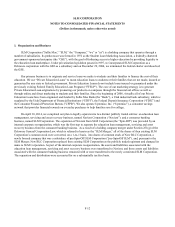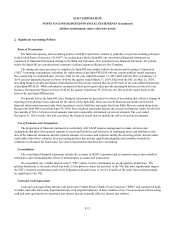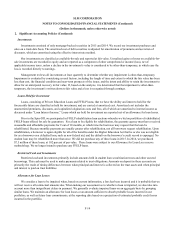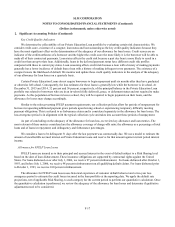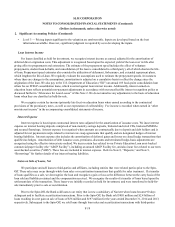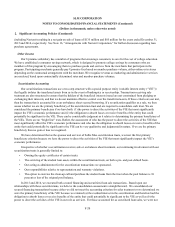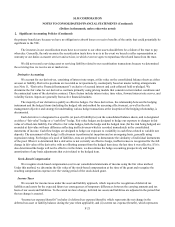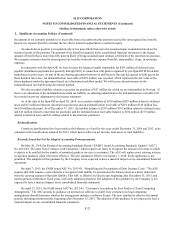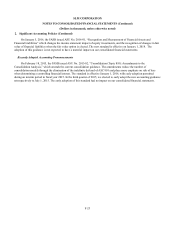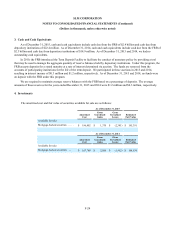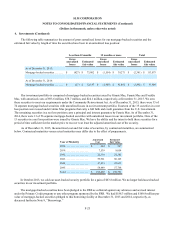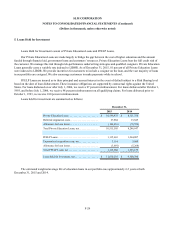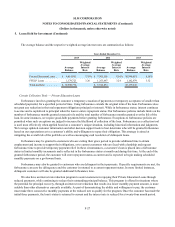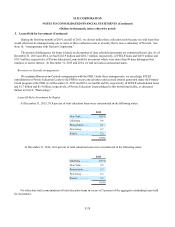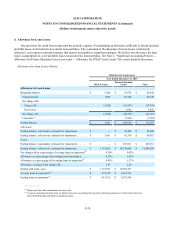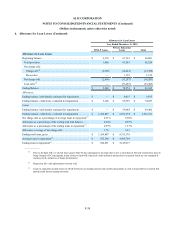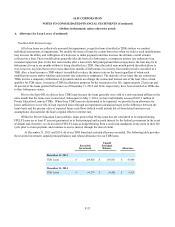Sallie Mae 2015 Annual Report Download - page 112
Download and view the complete annual report
Please find page 112 of the 2015 Sallie Mae annual report below. You can navigate through the pages in the report by either clicking on the pages listed below, or by using the keyword search tool below to find specific information within the annual report.SLM CORPORATION
NOTES TO CONSOLIDATED FINANCIAL STATEMENTS (Continued)
(Dollars in thousands, unless otherwise noted)
2. Significant Accounting Policies (Continued)
F-22
the amount of tax currently payable to or receivable from a tax authority plus amounts accrued for unrecognized tax benefits.
Income tax expense/(benefit) excludes the tax effects related to adjustments recorded in equity.
An uncertain tax position is recognized only if it is more likely than not to be sustained upon examination based on the
technical merits of the position. The amount of tax benefit recognized in the consolidated financial statements is the largest
amount of benefit that is more than fifty percent likely of being sustained upon ultimate settlement of the uncertain tax position.
We recognize interest related to unrecognized tax benefits in income tax expense/(benefit), and penalties, if any, in operating
expenses.
In connection with the Spin-Off, we have become the taxpayer legally responsible for $283 million of deferred taxes
payable (installment payments due quarterly through 2018) in connection with gains recognized by pre-Spin-Off SLM on debt
repurchases in prior years. As part of the tax sharing agreement between us and Navient, Navient has agreed to fully pay us for
these deferred taxes due. An indemnification receivable of $291 million was recorded, which represents the fair value of the
future payments under the agreement based on a discounted cash flow model. We will accrue interest income on the
indemnification receivable using the interest method.
We also recorded a liability related to uncertain tax positions of $27 million for which we are indemnified by Navient. If
there is an adjustment to the indemnified uncertain tax liability, an offsetting adjustment to the indemnification receivable will
be recorded as pre-tax adjustment to the income statement.
As of the date of the Spin-Off on April 30, 2014, we recorded a liability of $310 million ($283 million related to deferred
taxes and $27 million related to uncertain tax positions) and an indemnification receivable of $291 million ($310 million less
the $19 million discount). As of December 31, 2015, the liability balance is $207 million ($191 million related to deferred taxes
and $16 million related to uncertain tax positions) and the indemnification receivable balance is $186 million ($170 million
related to deferred taxes and $16 million related to uncertain tax positions).
Reclassifications
Certain reclassifications have been made to the balances as of and for the years ended December 31, 2014 and 2013, to be
consistent with classifications adopted for 2015, which had no effect on net income, total assets or total liabilities.
Recently Issued but Not Yet Adopted Accounting Pronouncements
On May 28, 2014, the Financial Accounting Standards Board (“FASB”) issued Accounting Standards Update (“ASU”)
No. 2014-09, “Revenue from Contracts with Customers,” which requires an entity to recognize the amount of revenue to which
it expects to be entitled for the transfer of promised goods or services to customers. The ASU will replace most existing revenue
recognition guidance when it becomes effective. The new standard is effective on January 1, 2018. Early application is not
permitted. The adoption of this guidance by the Company is not expected to have a material impact on its consolidated financial
statements.
On April 7, 2015, the FASB issued ASU No. 2015-03, “Simplifying the Presentation of Debt Issuance Costs.” The ASU
requires that debt issuance costs related to a recognized debt liability be presented in the balance sheet as a direct deduction
from the carrying amount of that debt liability. This ASU is effective for fiscal years beginning after December 15, 2015, and
interim periods within those fiscal years, with early adoption permitted. The adoption of this guidance by the Company is not
expected to have a material impact on its consolidated financial statements.
On April 15, 2015, the FASB issued ASU No. 2015-05, “Customer's Accounting for Fees Paid in a Cloud Computing
Arrangement.” The ASU amends its guidance on internal use software to clarify how customers in cloud computing
arrangements should determine whether the arrangement includes a software license. The new standard is effective for annual
periods, including interim periods, beginning after December 15, 2015. The adoption of this guidance is not expected to have a
material impact on our consolidated financial statements.


